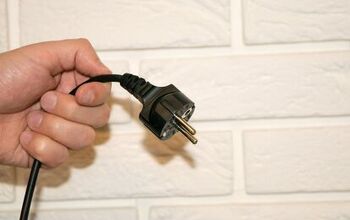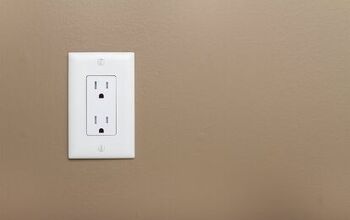How To Tell If An Outlet Is 110v Or 220v (Find Out Now!)

We tend to take our power outlets for granted. They are seemingly just there to accommodate our every need without batting an eyelash. But there are two main types of power outlets to be aware of: 110V and 220V.
A 220V plug has two hot terminals, and the hot wires are both black and red. On the other hand, a 110V has only a single hot terminal, and the hot wire will always be black. Common household appliances run off of 110V power. As such, 110V outlets are more prevalent throughout a house.
Do You Need to Hire an Electrician?
Get free, zero-commitment quotes from pro contractors near you.

What’s The Difference Between 110V And 220V Power?
It is important to know that the 110/220 distinction isn’t a hard line for everything. You will also likely see 110-volt service to describe 115, 120, and even 125 volts. The 220-volt service, meanwhile, can be used to describe 230, 240, and 250 volts.
Hot Wires
Electricity typically goes into a home through the power line transformer. This is done through a pair of hot wires that have a level of 240 volts of effective voltage between them. Each of the wires attaches to something known as a bus bar located in the main panel. The return, or neutral bus, then sends a single wire back into the transformer.
For voltage between the neutral bus and each hot bus is nominal at 120 volts. The voltage will fluctuate as it courses through each of the circuits in a home, accounting for the varying designations that you may see from time to time.
110V is the Most Common
Generally speaking, most of your household appliances and lights will run on 110-volt power. Through a single hot wire, they connect to the panel at one hot bus, a neutral wire, and a ground wire. When it comes to larger appliances – your dryer, for example – those are typically of the 220-volt variety. These connect to your panel through a pair of hot wires for each bus bar as well as the ground and neutral wires.
220-Volts Requires Double Pole Breakers
The number isn’t just a simple designation. It means that there are other requirements that must be met to provide that 220 voltage to your home. Since it is a switch, the circuit breaker has to be installed in the hot leg of that circuit that it is meant to control.
The easiest way to achieve this feat is to snap the breaker to the hot bus. Then, connect it to the corresponding hot wire for the specific circuit that it is meant to control.
Different hot wires. When you have a 110-volt circuit, each of them connects to a single bus bar. Moreover, they only have one hot wire, so you only need one circuit breaker to get the job done.
On the flip side, a 220-volt circuit will connect to two separate hot bars. That means you will need two breakers to get the job done. One of them will connect to a bus bar as well as each of the wires that connects to the bar. You may also hear a 220-volt breaker called a double-pole breaker because it has a pair of 110-volt breakers that have been bonded together.
Related Guide: Do I Need A Permit To Install 240v Outlet?
What Is The Difference Between 110-volt And 220-volt Outlets?
Knowing the visual difference between a 110-volt and 220-volt outlet may be difficult if you don’t know what to look for. The good news is that they are relatively easy to tell apart if you can spot the visual differences.
110-volt Outlets
For starters, almost every single 110-volt outlet looks the same as the rest. You know the kind: they have a pair of vertical slots that are side by side. If the outlet is polarized, there’s a chance that one of them may be larger than the others.
110-volt outlets also tend to have a third slot which is semicircular and basically forms a triangle with the other slots. The semicircular slot is for the ground pin. You will find these outlets just about anywhere in homes, hotels, commercial buildings, etc.
220-volt Outlets
The bad news is that there is no commonality when it comes to 220-volt outlets. While most 110-volt outlets are generally the same, there are different pin configurations for 220-volt outlets. The configuration will depend on the current rating of the breaker that controls the circuit.
There are a few differences that are key between the 110-volt and 220-volt outlets, though. The first is that the 220-volt is larger visually speaking. It will generally be round and either dark brown or black, not white as the 110-volt is. It can also have a fourth slot; the fourth slot is generally a ground wire. The slots can also be set at an angle, not just horizontally. Finally, they will generally be installed in pairs known as duplexes.
Do You Need to Hire an Electrician?
Get free, zero-commitment quotes from pro contractors near you.

What Will You Find Inside Of A 110-volt Or 220-volt Outlet?
Now that we know what to look for on the outside, it is still important to know what is happening beneath the outlet cover. The biggest noticeable difference is that the 220-volt wiring diagram will show you two hot wires instead of one.
Hot Terminals
This means that the 220-volt plug requires an extra hot terminal; these are conventionally made of brass. Another conventional feature is that the hot wires for a 220-volt outlet are colored red and black. The 110-volt outlet and plug, meanwhile, will only have one hot terminal where the wire will always be black.
Wire Size
The wire size is another distinguishing factor between the two voltage types. Since 220-volt circuits are carrying a higher current, they will require a wire gauge of 10 or higher. The standard 110-volt circuit, meanwhile, normally has a maximum of 12 gauge. The terminal screws in a 220-volt outlet also tend to be larger as well.
What’s An Easy Way To Tell The Voltage Of An Outlet?
All of these factors will make it easy to visually identify the different voltage types. But what about another way? What happens if you just aren’t certain whether you are staring down a 110-volt or a 220-volt outlet, there is another way.
Break out the multimeter. If you are having any doubts as to the voltage of your outlet, the best way to check is using a multimeter. Voltage numbers can fluctuate a little bit, but there is one consistency. All low-power outlets should measure somewhere between 110- to 130-volts. The high-power outlets, meanwhile, should fall in the 200- to 240-volt range. Remove any doubt by using a multimeter to tell you the voltage you are working with.
What Are Signs That An Electrical Circuit Is Overloaded?
Past the electrical outlets is the electrical circuit. This is what delivers power to each of these outlets and allows them to perform their task. From time to time, the circuit can become overloaded. Sometimes it is as simple as the breaker isn’t working at all but there are other telltale signs that your circuit may be overloaded.
- Flickering/blinking/dimming. If you notice that the things plugged into your outlets are flickering or blinking (or dimming in the case of lamps or lights), that could be an indication that the circuit is doing too much. Try the appliance in another place to see if the problem persists.
- Frequent tripping. When a circuit is overloaded, it will trip to prevent a short. If all things are functioning normally, you shouldn’t see a trip very often. When the breaker keeps tripping, it is an indication that the load is too great and your breaker’s safety measure is kicking in.
- Plates are discolored or warm. Electrical currents generate heat. If the circuit is overloaded, there is a chance that it could be producing too much of a current. Too much current could mean overheating at the plates, causing a warm feeling or even discoloration in the plate. Check the breaker immediately if you notice one of these.
- Burning odor. Likewise, if you notice a burning smell coming from your wall switches or outlets, it could be another indication that the breaker is overloaded. A lot of heat can result in the burning of wires or worse in extreme situations.
Summary
Throughout your house, 110V outlets are more common than 220V outlets. Appliances that require more power, like a dryer, need a 220V outlet.
Aside from their physical external appearance, 110V and 220V outlets have different wiring. A 110V has a single hot terminal whose wire is always black, while a 220V has two hot terminals with a black and red wire.
Related Guides

Ryan Womeldorf has more than a decade of experience writing. He loves to blog about construction, plumbing, and other home topics. Ryan also loves hockey and a lifelong Buffalo sports fan.
More by Ryan Womeldorf



























